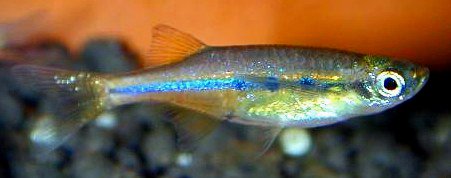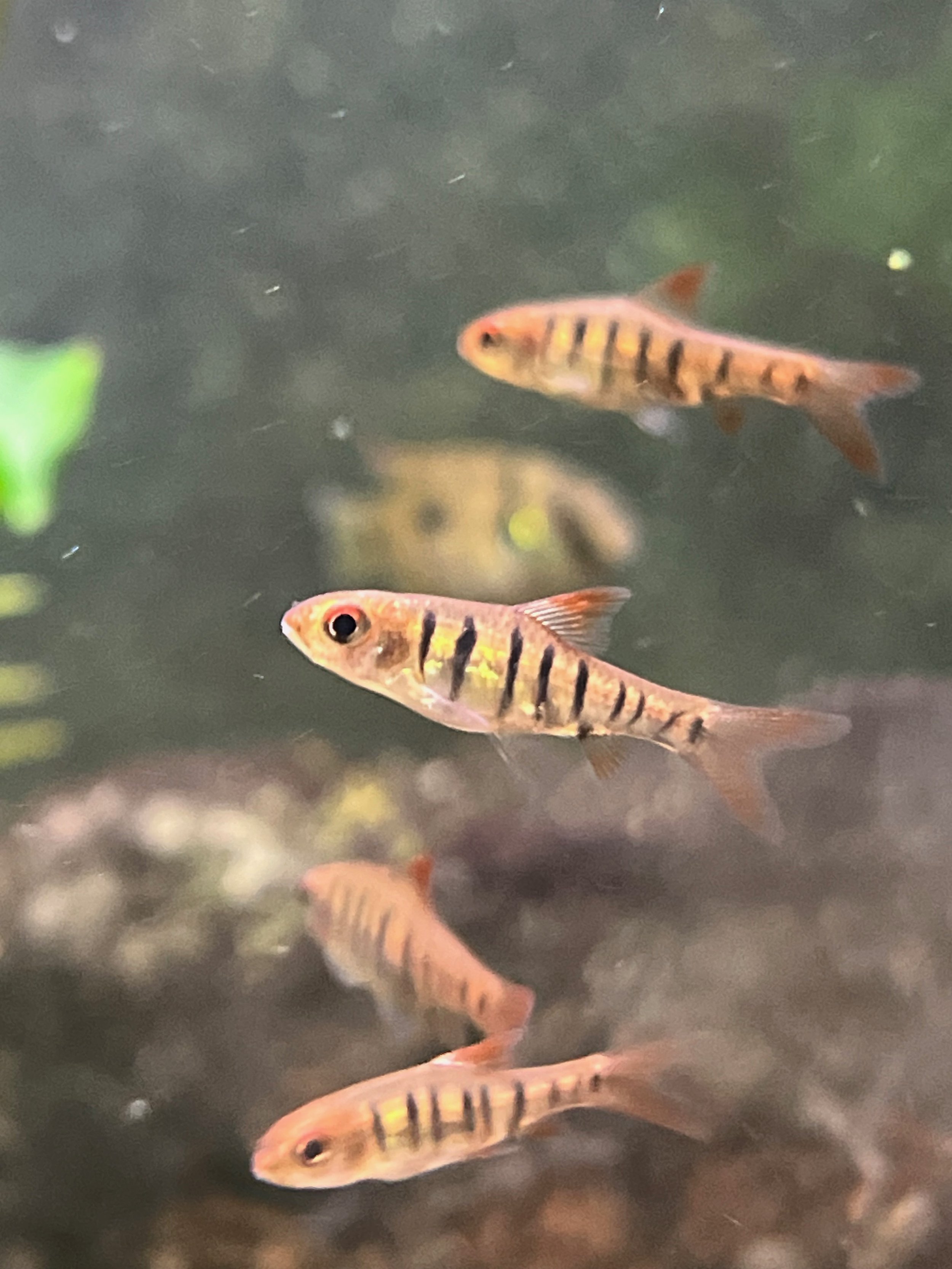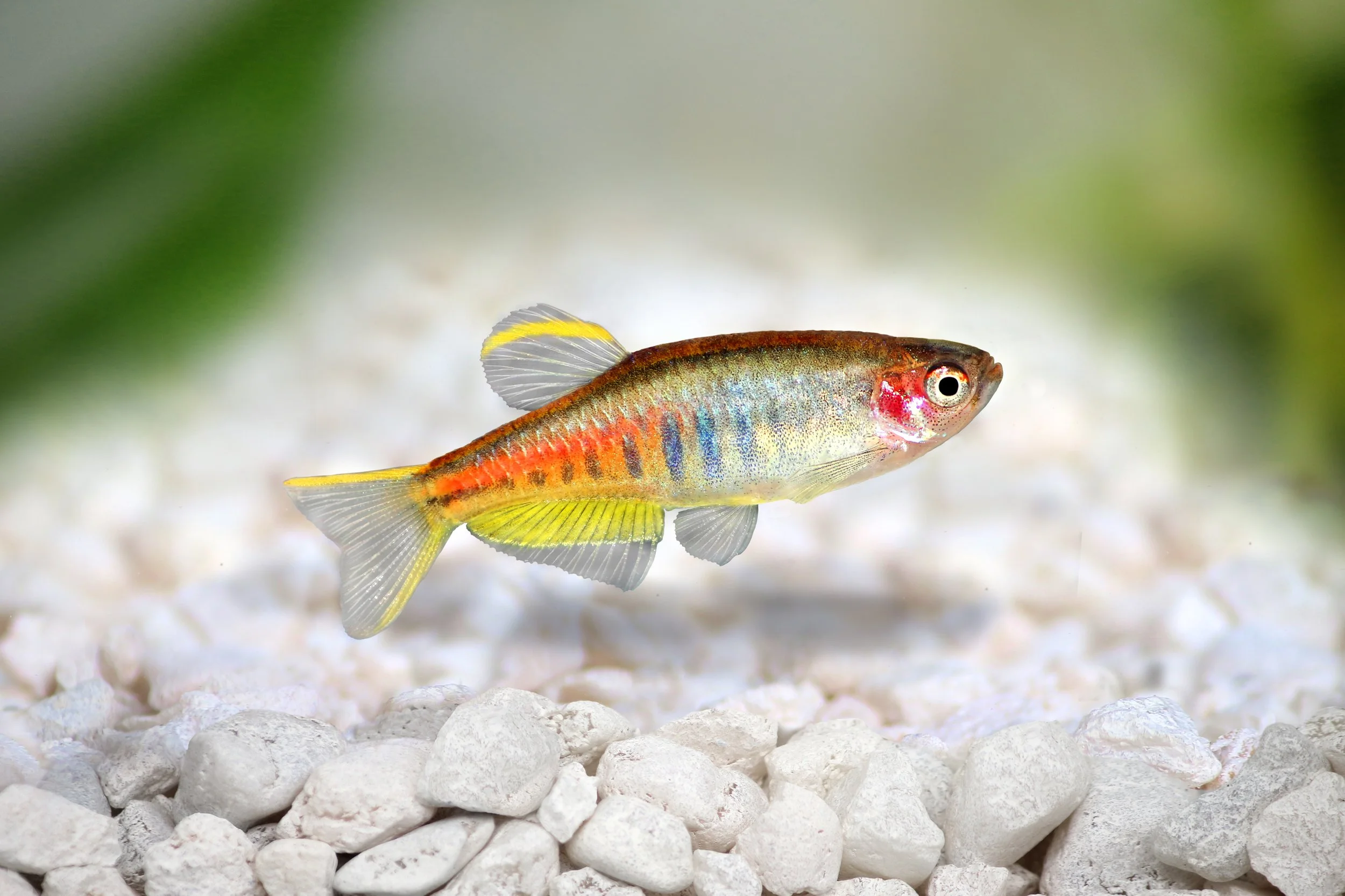 Image 1 of 2
Image 1 of 2

 Image 2 of 2
Image 2 of 2



Orange Hatchet
The Orange Hatchet, scientifically known as Neochela dadiburjori, is a captivating and unique freshwater fish species that stands out for its vibrant coloration and intriguing body shape. Native to India, particularly in the slow-moving rivers and streams of the Western Ghats, this species is a relatively rare yet exciting addition to nano and planted aquariums.
Physically, the Orange Hatchet features a distinctive hatchet-shaped body, with a deep, laterally compressed profile and a slightly upturned mouth. Its most striking feature is its vivid orange coloration, which extends across its entire body, making it a standout in any aquarium setup. Mature specimens typically reach lengths of around 1.5 inches (3.8 centimeters), making them ideal for smaller tanks and nano setups.
In aquariums, Orange Hatchets thrive in well-planted tanks with plenty of open swimming space and gentle water flow. They appreciate the presence of floating plants and dense vegetation, which provide cover and help mimic their natural habitat. Due to their relatively peaceful nature, they can be kept with other small, non-aggressive fish species, making them suitable for community tanks.
Water parameters for Orange Hatchets should closely resemble those of their native environment. They prefer slightly acidic to neutral water with a pH range of 6.0 to 7.0 and temperatures between 72 to 79°F (22 to 26°C). Maintaining stable water conditions with regular water changes and good filtration is crucial for their well-being.
Feeding Orange Hatchets is relatively straightforward, as they are omnivorous and accept a variety of foods. They readily consume high-quality flakes, pellets, and micro-pellets, as well as live or frozen foods such as daphnia, brine shrimp, and bloodworms. Providing a varied diet ensures that they receive essential nutrients and helps maintain their vibrant coloration and overall health.
Breeding Orange Hatchets in captivity can be challenging due to their specific habitat requirements and behavior. To encourage breeding, provide a separate breeding tank with fine-leaved plants or spawning mops. Soft, slightly acidic water conditions and a gentle water flow can help simulate their natural breeding environment. Once eggs are laid, the adults should be removed to prevent them from consuming the eggs. The eggs typically hatch within a few days, and the fry can be raised on infusoria or other microscopic foods until they are large enough to consume baby brine shrimp or finely powdered fry food.
Overall, the Orange Hatchet (Neochela dadiburjori) is a fascinating and visually striking addition to freshwater aquariums, prized for its unique body shape, vibrant coloration, and peaceful demeanor. With proper care and attention to their specific requirements, these captivating fish can thrive and bring joy to aquarists of all levels of experience, adding beauty and intrigue to any aquatic environment.
The Orange Hatchet, scientifically known as Neochela dadiburjori, is a captivating and unique freshwater fish species that stands out for its vibrant coloration and intriguing body shape. Native to India, particularly in the slow-moving rivers and streams of the Western Ghats, this species is a relatively rare yet exciting addition to nano and planted aquariums.
Physically, the Orange Hatchet features a distinctive hatchet-shaped body, with a deep, laterally compressed profile and a slightly upturned mouth. Its most striking feature is its vivid orange coloration, which extends across its entire body, making it a standout in any aquarium setup. Mature specimens typically reach lengths of around 1.5 inches (3.8 centimeters), making them ideal for smaller tanks and nano setups.
In aquariums, Orange Hatchets thrive in well-planted tanks with plenty of open swimming space and gentle water flow. They appreciate the presence of floating plants and dense vegetation, which provide cover and help mimic their natural habitat. Due to their relatively peaceful nature, they can be kept with other small, non-aggressive fish species, making them suitable for community tanks.
Water parameters for Orange Hatchets should closely resemble those of their native environment. They prefer slightly acidic to neutral water with a pH range of 6.0 to 7.0 and temperatures between 72 to 79°F (22 to 26°C). Maintaining stable water conditions with regular water changes and good filtration is crucial for their well-being.
Feeding Orange Hatchets is relatively straightforward, as they are omnivorous and accept a variety of foods. They readily consume high-quality flakes, pellets, and micro-pellets, as well as live or frozen foods such as daphnia, brine shrimp, and bloodworms. Providing a varied diet ensures that they receive essential nutrients and helps maintain their vibrant coloration and overall health.
Breeding Orange Hatchets in captivity can be challenging due to their specific habitat requirements and behavior. To encourage breeding, provide a separate breeding tank with fine-leaved plants or spawning mops. Soft, slightly acidic water conditions and a gentle water flow can help simulate their natural breeding environment. Once eggs are laid, the adults should be removed to prevent them from consuming the eggs. The eggs typically hatch within a few days, and the fry can be raised on infusoria or other microscopic foods until they are large enough to consume baby brine shrimp or finely powdered fry food.
Overall, the Orange Hatchet (Neochela dadiburjori) is a fascinating and visually striking addition to freshwater aquariums, prized for its unique body shape, vibrant coloration, and peaceful demeanor. With proper care and attention to their specific requirements, these captivating fish can thrive and bring joy to aquarists of all levels of experience, adding beauty and intrigue to any aquatic environment.
The Orange Hatchet, scientifically known as Neochela dadiburjori, is a captivating and unique freshwater fish species that stands out for its vibrant coloration and intriguing body shape. Native to India, particularly in the slow-moving rivers and streams of the Western Ghats, this species is a relatively rare yet exciting addition to nano and planted aquariums.
Physically, the Orange Hatchet features a distinctive hatchet-shaped body, with a deep, laterally compressed profile and a slightly upturned mouth. Its most striking feature is its vivid orange coloration, which extends across its entire body, making it a standout in any aquarium setup. Mature specimens typically reach lengths of around 1.5 inches (3.8 centimeters), making them ideal for smaller tanks and nano setups.
In aquariums, Orange Hatchets thrive in well-planted tanks with plenty of open swimming space and gentle water flow. They appreciate the presence of floating plants and dense vegetation, which provide cover and help mimic their natural habitat. Due to their relatively peaceful nature, they can be kept with other small, non-aggressive fish species, making them suitable for community tanks.
Water parameters for Orange Hatchets should closely resemble those of their native environment. They prefer slightly acidic to neutral water with a pH range of 6.0 to 7.0 and temperatures between 72 to 79°F (22 to 26°C). Maintaining stable water conditions with regular water changes and good filtration is crucial for their well-being.
Feeding Orange Hatchets is relatively straightforward, as they are omnivorous and accept a variety of foods. They readily consume high-quality flakes, pellets, and micro-pellets, as well as live or frozen foods such as daphnia, brine shrimp, and bloodworms. Providing a varied diet ensures that they receive essential nutrients and helps maintain their vibrant coloration and overall health.
Breeding Orange Hatchets in captivity can be challenging due to their specific habitat requirements and behavior. To encourage breeding, provide a separate breeding tank with fine-leaved plants or spawning mops. Soft, slightly acidic water conditions and a gentle water flow can help simulate their natural breeding environment. Once eggs are laid, the adults should be removed to prevent them from consuming the eggs. The eggs typically hatch within a few days, and the fry can be raised on infusoria or other microscopic foods until they are large enough to consume baby brine shrimp or finely powdered fry food.
Overall, the Orange Hatchet (Neochela dadiburjori) is a fascinating and visually striking addition to freshwater aquariums, prized for its unique body shape, vibrant coloration, and peaceful demeanor. With proper care and attention to their specific requirements, these captivating fish can thrive and bring joy to aquarists of all levels of experience, adding beauty and intrigue to any aquatic environment.





